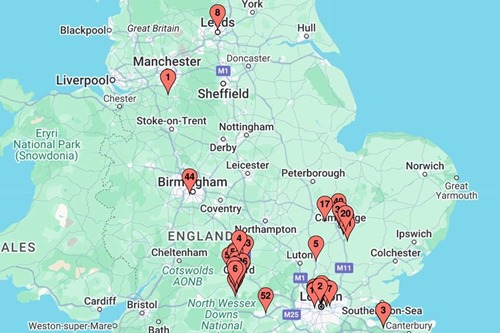What lab tenants want: regional differences in how lab space is marketed in the UK
/Lab_tenant_market.jpg)
In the UK's growing lab real estate market, agents are increasingly focused on marketing the specific features that set one building apart from another. Our analysis of 63 active lab listings' summary pages (each highlighting four key amenities) provides insight into what agents consider most marketable at first glance, without delving into detailed linked information.
Of the total sample, 25 percent of the listings were in London, 59 per cent in Oxford and Cambridge, and 16 per cent outside the Golden Triangle. Our analysis reveals distinct regional patterns in how lab spaces are marketed, with technical specifications dominating London listings while practical amenities feature more prominently elsewhere.
London's technical focus
In London, the most prominent features are those directly related to scientific use and technical readiness. Half of the 16 listings referenced CL2 laboratories—facilities designed for safe handling of moderate-risk biological materials.
Connections to research institutions such as the Francis Crick Institute, Imperial College London, or UCL were also common, appearing in nearly one-third of London listings.338 Euston Road is shown in yellow above (source: buildington.co.uk)
338 Euston Road is a 115,000 sq ft office building at Regent's Place campus in London NW1, arranged over 17 storeys and is multi-let. Space is available on the 8th floor and one of its selling points is the link to UCL and Francis Crick Institute. The space is described as a fitted CL2 wet lab and office facility split 60/40.
Regional priorities
Outside London, a markedly different emphasis emerges. Regional listings are more likely to highlight building services and practical day-to-day amenities. Car parking, for example, is frequently cited, often with specific capacity figures. LED lighting and air conditioning are also prominent.
The disparity in air conditioning mentions is particularly striking—while over one-fifth of non-London properties highlight this feature, not a single London listing does so. Similarly, on-site cafés appear far more frequently in regional listings, likely reflecting the self-contained nature of many science parks compared to London's abundant dining options.
This pattern becomes even more pronounced when examining properties completely outside the Golden Triangle. In locations such as Macclesfield, Sittingbourne, and Birmingham, 60 per cent of listings highlight LED lighting, 50 per cent feature air conditioning, and 40 per cent mention on-site cafés.
Size and amenity relationships
The analysis reveals a notable correlation between location and size of the listing. London lab spaces are disproportionately represented in the large size bracket, with almost 70 per cent of London listings being for spaces of 5,000 square feet or larger, compared to 45 per cent of non-London properties.
Certain features like EV charging and showers are usually associated with larger properties across all locations, suggesting these amenities become more economically viable at scale.
Cycle storage presents an intriguing pattern: it's mentioned in approximately 20 per cent of both small properties and large ones, but remarkably absent in all medium-sized listings. But this feature may be more closely connected with location than size of the unit available: all the labs that mention cycle storage are in Oxford or Cambridge, with just one exception (in Leeds).Nexus building in Leeds offers bike racks (source: Leeds University)
The contrasts between London and regional lab spaces are striking. London lab buildings are marketed with an emphasis on technical readiness, biosafety specifications, and research network integration. Non-London listings lead with accessibility, infrastructure, and convenience—factors that appeal to a broader cross-section of tenants.
Agents tailor their listings differently based on location, emphasising different amenities that they believe will appeal to the target audience in each market. For developers and landlords, understanding these regional marketing trends may help inform investment decisions and property positioning strategies. For prospective tenants, recognising these patterns can help set realistic expectations when searching for lab space in different regions.
As the UK lab market matures, these patterns may shift, but for now, they provide a useful snapshot of how location informs not just demand—but the way lab space is presented and marketed to scientific enterprises across the country.
Noteworthy unique amenities
"330 lockers": this specific amenity in London is interesting for its precise quantification. While many listings mention storage facilities more generally, this level of specificity indicates a property that's positioning itself for high-density occupancy with robust personal storage options - possibly targeting multi-tenant arrangements.
"Broadband": given that high-speed internet would seem to be a fundamental requirement for any modern lab space, its inclusion in the top four amenities was unexpected.
Comments
- This email is for internal purposes and will not be shown
- CommentThis article was first published in May 2025 here: https://www.lifesciencesrealestate.org/life-sciences-real-estate-50/
- Are you a member? Log in to comment
/)


/canvascolor(0xffffffff)/logo2024TV.png)
/canvascolor(0xffffffff)/2017_11_13_Spain_Tecnocampus_3.jpg)
/canvascolor(0xffffffff)/2018_01_24_Italy_Kilometro_Rosso.png)
/canvascolor(0xffffffff)/Logo_PEGUlm_neu.jpg)
/canvascolor(0xffffffff)/MemberLogo-75401-5958.jpg)
/canvascolor(0xffffffff)/2017_11_17_Taiwan_Southern_Taiwan_SP.png)
/canvascolor(0xffffffff)/Aj_basa_2014_color-fonsgrisE_2.png)
/canvascolor(0xffffffff)/2025_03_04_Germany_Ostfalen.png)
/canvascolor(0xffffffff)/Lion_scienc_park_black_trans_3.png)
/canvascolor(0xffffffff)/logo-eng_4.png)
/canvascolor(0xffffffff)/HIPB_Logo_2.jpg)
/canvascolor(0xffffffff)/HiRes_logo_transparent.png)
/canvascolor(0xffffffff)/Jinnovation_Park_logo.png)
/canvascolor(0xffffffff)/RSTP_Logo-01_8.png)
/canvascolor(0xffffffff)/MemberLogo-5545-5950.jpg)
/canvascolor(0xffffffff)/ODTU_TEKNOKENT_logo_2016.png)
/canvascolor(0xffffffff)/MemberLogo-87901-361401.png)
/canvascolor(0xffffffff)/BV_Logo_HS_1.png)
/canvascolor(0xffffffff)/Logo_22.png)
/canvascolor(0xffffffff)/MemberLogo-5557-5966.jpg)
/canvascolor(0xffffffff)/MemberLogo-5779-6245.jpg)
/canvascolor(0xffffffff)/2020_09_24_Turkey_Teknopark_Istanbul.png)
/canvascolor(0xffffffff)/Teknopark_vekt_rel_logo_page-0001_1.jpg)
/canvascolor(0xffffffff)/WhatsApp_Image_2020-03-12_at_10.51.40.jpg)
/canvascolor(0xffffffff)/2017_08_07_Pando.png)
